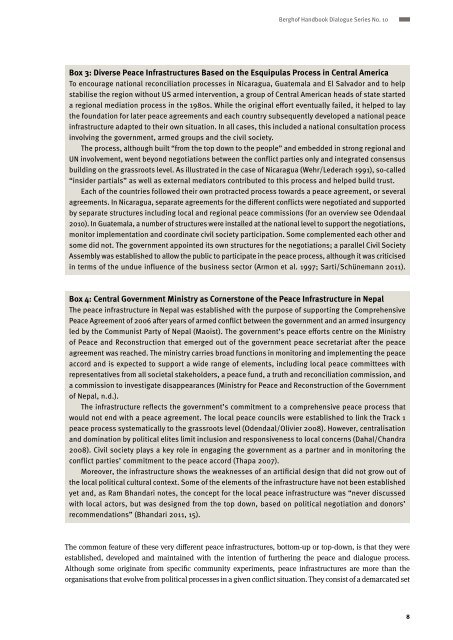Giving Peace an Address? - Berghof Handbook for Conflict ...
Giving Peace an Address? - Berghof Handbook for Conflict ...
Giving Peace an Address? - Berghof Handbook for Conflict ...
You also want an ePaper? Increase the reach of your titles
YUMPU automatically turns print PDFs into web optimized ePapers that Google loves.
<strong>Berghof</strong> H<strong>an</strong>dbook Dialogue Series No. 10<br />
Box 3: Diverse <strong>Peace</strong> Infrastructures Based on the Esquipulas Process in Central America<br />
To encourage national reconciliation processes in Nicaragua, Guatemala <strong>an</strong>d El Salvador <strong>an</strong>d to help<br />
stabilise the region without US armed intervention, a group of Central Americ<strong>an</strong> heads of state started<br />
a regional mediation process in the 1980s. While the original ef<strong>for</strong>t eventually failed, it helped to lay<br />
the foundation <strong>for</strong> later peace agreements <strong>an</strong>d each country subsequently developed a national peace<br />
infrastructure adapted to their own situation. In all cases, this included a national consultation process<br />
involving the government, armed groups <strong>an</strong>d the civil society.<br />
The process, although built “from the top down to the people” <strong>an</strong>d embedded in strong regional <strong>an</strong>d<br />
UN involvement, went beyond negotiations between the conflict parties only <strong>an</strong>d integrated consensus<br />
building on the grassroots level. As illustrated in the case of Nicaragua (Wehr/Lederach 1991), so-called<br />
“insider partials” as well as external mediators contributed to this process <strong>an</strong>d helped build trust.<br />
Each of the countries followed their own protracted process towards a peace agreement, or several<br />
agreements. In Nicaragua, separate agreements <strong>for</strong> the different conflicts were negotiated <strong>an</strong>d supported<br />
by separate structures including local <strong>an</strong>d regional peace commissions (<strong>for</strong> <strong>an</strong> overview see Odendaal<br />
2010). In Guatemala, a number of structures were installed at the national level to support the negotiations,<br />
monitor implementation <strong>an</strong>d coordinate civil society participation. Some complemented each other <strong>an</strong>d<br />
some did not. The government appointed its own structures <strong>for</strong> the negotiations; a parallel Civil Society<br />
Assembly was established to allow the public to participate in the peace process, although it was criticised<br />
in terms of the undue influence of the business sector (Armon et al. 1997; Sarti/Schünem<strong>an</strong>n 2011).<br />
Box 4: Central Government Ministry as Cornerstone of the <strong>Peace</strong> Infrastructure in Nepal<br />
The peace infrastructure in Nepal was established with the purpose of supporting the Comprehensive<br />
<strong>Peace</strong> Agreement of 2006 after years of armed conflict between the government <strong>an</strong>d <strong>an</strong> armed insurgency<br />
led by the Communist Party of Nepal (Maoist). The government’s peace ef<strong>for</strong>ts centre on the Ministry<br />
of <strong>Peace</strong> <strong>an</strong>d Reconstruction that emerged out of the government peace secretariat after the peace<br />
agreement was reached. The ministry carries broad functions in monitoring <strong>an</strong>d implementing the peace<br />
accord <strong>an</strong>d is expected to support a wide r<strong>an</strong>ge of elements, including local peace committees with<br />
representatives from all societal stakeholders, a peace fund, a truth <strong>an</strong>d reconciliation commission, <strong>an</strong>d<br />
a commission to investigate disappear<strong>an</strong>ces (Ministry <strong>for</strong> <strong>Peace</strong> <strong>an</strong>d Reconstruction of the Government<br />
of Nepal, n.d.).<br />
The infrastructure reflects the government’s commitment to a comprehensive peace process that<br />
would not end with a peace agreement. The local peace councils were established to link the Track 1<br />
peace process systematically to the grassroots level (Odendaal/Olivier 2008). However, centralisation<br />
<strong>an</strong>d domination by political elites limit inclusion <strong>an</strong>d responsiveness to local concerns (Dahal/Ch<strong>an</strong>dra<br />
2008). Civil society plays a key role in engaging the government as a partner <strong>an</strong>d in monitoring the<br />
conflict parties’ commitment to the peace accord (Thapa 2007).<br />
Moreover, the infrastructure shows the weaknesses of <strong>an</strong> artificial design that did not grow out of<br />
the local political cultural context. Some of the elements of the infrastructure have not been established<br />
yet <strong>an</strong>d, as Ram Bh<strong>an</strong>dari notes, the concept <strong>for</strong> the local peace infrastructure was “never discussed<br />
with local actors, but was designed from the top down, based on political negotiation <strong>an</strong>d donors’<br />
recommendations” (Bh<strong>an</strong>dari 2011, 15).<br />
The common feature of these very different peace infrastructures, bottom-up or top-down, is that they were<br />
established, developed <strong>an</strong>d maintained with the intention of furthering the peace <strong>an</strong>d dialogue process.<br />
Although some originate from specific community experiments, peace infrastructures are more th<strong>an</strong> the<br />
org<strong>an</strong>isations that evolve from political processes in a given conflict situation. They consist of a demarcated set<br />
8
















